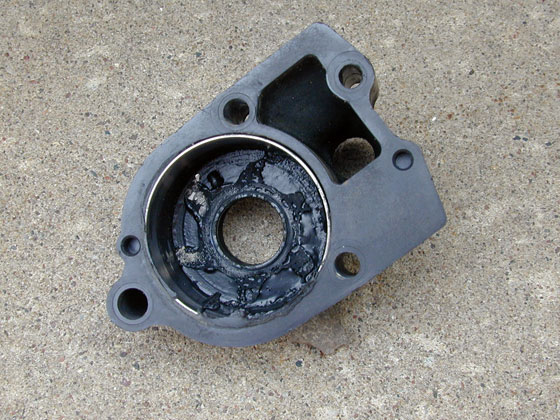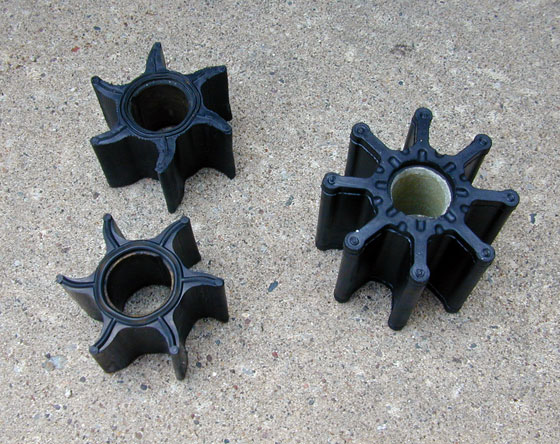Should You Just Change The Impeller Or Whole Water Pump Kit
Outboard Practiced: Water Pump Impellers
Outboard water pump impellers can't have corruption, and so annual water pump maintenance is cheap insurance.
The water pump impeller of any outboard motor needs to be serviced on a regular basis, a task that if overlooked can lead to big trouble. Most outboard maintenance schedules call for inspection of the impeller every 100 hours, or once a twelvemonth. And once you've paid a tech to drop the gearcase and look at the impeller, you lot might likewise spend another $25 and get a new one installed. The entire job is almost $100 of cheap insurance.

The torn-upwards blades of this inboard impeller are not going to move much water.
The impeller itself is merely a serial of rubber vanes molded around a hub. The vanes are flexible, and the hub rotates on an eccentric within the pump housing, which has a stainless steel liner. The tips of the impeller vanes can clothing out from unproblematic use, but if the motor is oftentimes run in silty or sandy weather condition, this abrasive material tin can accelerate impeller vesture. The rubber material can also get stiff and brittle, a common problem on motors that sit down unused for several seasons. Then the vanes tin can "accept a set" in one position and not flex back. The other impeller-killer is estrus. Water lubricates the pump, and if it'due south run dry the impeller can be ruined in just seconds.
Note I said impeller service requires "dropping the gearcase." For most of us checking the impeller is non a do-it-yourself project, which is probably why and so many impellers are neglected until they neglect.
"I call up the nigh-common cause of impeller failure I see is simply old historic period," says Dan Jansen, the pb certified Mercury technician at Mr. Marine in Addicted du Lac, Wis. "Even with our short flavour, I find a lot of impellers that are too worn at the tips to pump well, or are really stiff. We make changing the impeller function of our off-flavour lay-up program, because if information technology fails you lot tin can accept much more expensive bug."

This Mercury outboard water pump was run dry briefly, and the impeller literally melted within the housing. You can see the imprint of the impeller on the back. In this case the entire water pump was replaced.
When the impeller fails, the pump can't pump and the engine will overheat. I've seen old outboards that got then hot the paint burned off the powerhead. Most newer motors accept a alert horn that sounds when the motor gets hot, and a program that cuts engine rpm to attempt and protect the powerhead, simply Jansen thinks that often may be as well little, too late.
"If they are running broad-open, past the time they hear that horn and react, they accept a scuffed piston, especially if it'south a two-stroke motor," said Jansen, " And even if the motor is OK, now they are out in the centre of the lake and the day is shot, at the very least."
A ruined impeller can also be caused by running aground, says David Greenwood, product planning manager at Suzuki Marine.
"You tin suck a lot of annoying trash into the pump if you run the gearcase into a sand bar," says Greenwood. "I've seen cases where the water intakes were just packed to the point that water could not fifty-fifty get to the pump. If you make it that situation, it's a good idea to have the impeller checked only as a precaution."

The impeller to the right is new. The two to the left are old, with vanes that are worn, hard and curled over from sitting idle for years in an older motor.
Jansen and Greenwood agree that starting the engine "dry out," that is, with no water supply to the pump, is instant death to the impeller.
"A few years agone Suzuki actually did a report to see how long an impeller would last if you started the motor dry," said Greenwood, "and information technology was well-nigh twenty or xxx seconds."
Jansen showed me a Mercury outboard water pump housing he removed this flavour that is coated with melted rubber (see photo #2, above).
"The boat owner says he doesn't know what happened, but I know he started the motor in his driveway, just because he likes to hear that 2-stroke bawl," said Jansen. "This one got so hot yous tin see the stainless steel liner has actually recessed a trivial into the housing. The whole thing was melting."
Greenwood says he's seen gunkhole owners who give the motor a quick bump with the starter on the launch ramp, just to brand sure it'southward ready to go when they go far the water, and others who think they need to beginning the motor after pulling the boat out of the water to drain it. Both are large mistakes that volition ruin the impeller.
"Another issue is owners think they can starting time the motor if a hose is hooked up to the flush port," says Greenwood. "That pushes water through the powerhead and exhaust, but very petty gets to the pump. We tell owners to always use a fix of water muffs on the gearcase if they want to start the motor with the boat on a trailer."
If an impeller fails dramatically, simply installing new parts may not be the end of your trouble.
"If the impeller really comes apart, there's a practiced chance that trivial bits of rubber tin can get lodged in the h2o tube and restrict menstruation to the powerhead," says Greenwood. "You might observe a weak stream from the water pilot out the side of the motor, and that could hateful that the technician did not check for impeller debris. If that's uncorrected, the motor could overheat."
You've been warned. Replace that impeller at the terminate of this season.
![]() Charles Plueddeman is Boats.com's outboard, trailer, and PWC adept. He is a sometime editor at Boating Magazine and contributor to many national publications since 1986.
Charles Plueddeman is Boats.com's outboard, trailer, and PWC adept. He is a sometime editor at Boating Magazine and contributor to many national publications since 1986.
Should You Just Change The Impeller Or Whole Water Pump Kit,
Source: https://www.boats.com/reviews/outboard-expert-water-pump-impellers/
Posted by: phillipsnobjess76.blogspot.com


0 Response to "Should You Just Change The Impeller Or Whole Water Pump Kit"
Post a Comment